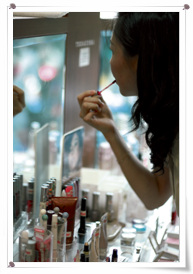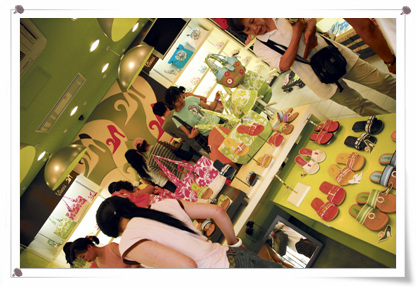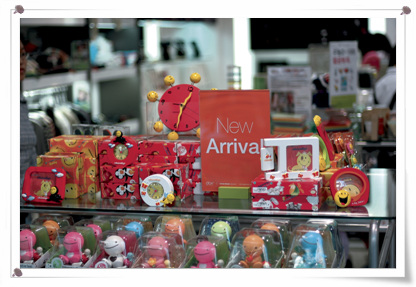Funology, the new trend
| THE LEADING trend of 2006: FUNOLOGY. Don't get it? Here's a hint: FUN + Technology. Still don't get it? Pay attention, this word could make you next year's smartest consumer or most successful businessman. "FUN" is literally everything that attracts people's interest and brings laughter. "Technology", usually referring to methods or systems related to science, actually extends to all businesses - meaning, everything. The combination of these two terms gives birth to a trend where fun becomes the main interest of both buyers and sellers: Funology, and its leading marketing strategy, FUN Marketing. |
Know the FUN! 
FUN Marketing, the rising trend of the business world, has introduced a new standard for choosing one product over another. "Today, it is hard to distinguish products by simply judging the "hardware", that is, the quality or the value," says Lee Yeon-su, researcher at the LG Economic Research Institute. "It is time for Sensibility Marketing." In short, it does not matter how good the quality is; if it fails to catch people's senses, it is as good as dead.
FUN marketing is all about stimulating the senses. Take publicity for example: Many commercials now simultaneously advertise the product and generate interest while making people laugh. A good example is the "Horizontal-instinct" cell phone commercial series. In one, people wear vertical glasses, as the slogan "Horizontal-instinct" scrolls horizontally. Also, teaser advertisements such as the classic "Sun-young, I love you" are also a good way of attracting attention. "It is not easy to decide which specific kind of advertisement is suitable for today's generation," says Kim Ju-hwa, member of the Y.A.C, an advertisement dongharee. "However, we can feel that companies spend a lot of time on commercials and try to appeal through image and sensibility." Indeed, publicity is expected to get more and more diverse and interesting.
Of course, FUN affects the product itself too. Original ideas transform everyday items into new interesting concepts. For example, the "boyfriend pillow" a pillow made like a man's shoulder- attracted a lot of attention when it first appeared. Other original items are also produced such as the Cup-ramen time-measurer.
Live the FUN! 
▲ New and Fun Unlike earlier advertisments which focused mostly on product image, recent commercials use "Fun" as their main concept.
Ah yes, the real FUN lies in the shopping experience itself. The enterprises did not miss this point. The cosmetics shop Toda Cosa for instance, allows visitors to test their products freely. "Before, employees kept bothering me, but now I can look, test and choose everything by myself," says Park Ae-young, a frequent visitor in her mid-twenties. Vianni, a shoe shop, changes its display every other week to offer consumers a new experience every visit. "This is what we call fun experience marketing," explains Lee. "It allows consumers to have an enjoyable time while shopping."
Apart from shopping, people can now "live the FUN" while enjoying a nice dinner outside. "Before, restaurants were mostly judged by either the menus or the atmosphere, but now some provide entertainment such as magic shows. The clients can thus experience a unique show," says Lee.
Public Competitions are another good way to allow consumers to participate in the fun of marketing. The shoe company Young Age hosts a "Young Age Fun & Free Idea Contest" every year, in which people submit an original shoe design or a commercial idea to advertise YA. "We judge the contestants' designs based on how fun they are, how realistic they are, and how new the concepts are," explains Han Jung-il (Manager, YA Marketing Team). Since 2002, YA has used this contest to attract new customers. "The contest encourages clients to come and visit more often and thus enjoy the newly made changes," explains Han. Because the winning prizes are either directly reflected in the store's publicity campaign or used in their marketing studies, more and more people are showing interest.
Lighting up the hard times 
▲ Free make-up Many cosmetic shops allow clients to "play" with their products.
Although the term Funology only appeared a year ago, the tendency to captivate the busy crowd with FUN has always been a business's favorite. Why then does a simple strategy get the spotlight all of a sudden?
Boldly put, companies need to survive during hard times. The most useful new tactic to vanquish this hardship seems to be FUN. "Although Korea's national financial situation is getting better, the general population does not feel so," explains Choi Min-ho, Market Researcher at IFNetwork, a Trend Information Consulting company. Lee adds, "Korea has been through a domestic economic dullness. People naturally keep their wallet well shut. Companies thus feel the need to induce these people to open up again. The best way so far is using a bright and fun approach."
Is FUN Marketing then a simple fast-selling strategy? Not exactly. "Consumers too require fun from companies," assures Choi. "Now, the new generation is into fun seeking," states Lee. "Unlike before, people get interested in anything that is fun, whether or not it is important." This tendency was first demonstrated on the Internet. "The Internet floods today's consumers with new information and trends," says Choi. "Fun items are no exception. People thus get easily bored and avoid the 'norm'." In short, people are always ready to welcome any fresh and amusing new idea.
FUN can be hard 
▲ Pretty, but... Flashy displays try to attract clients, but can the products live up to their image?
Despite the efforts made by companies to please the public, some are a bit clumsy right now. "Some enterprises are trying hard to be fun. But simply saying that 'this is Funology' doesn't make it automatically FUN," says Choi. His point of view is that some Korean companies are so anxious to imprint the word "fun" in people's mind that they forget that real Funology is when consumers themselves get interested and voluntarily participate.
This brings concerns about whether this type of marketing is actually effective. FUN marketing aims at captivating people's attention in a short matter of time. It can therefore easily degenerate into mere amusement. "People still regard 'fun' as a one-time, bizarre experiment or game. That is why fun marketing is very fragile. Even if it can attract consumers attention, it might not be able to make then pay anything," explains Lee. This is especially so if the companies consider FUN more important than the products' quality or value. In fact, when asked about the quality of the so-called fun products, several customers expressed discontentment: "Sure, the shoes are pretty and they are not very expensive, but they don't last for long," says a young student about the Vianni shoes. Another pointed out that although she often visits the dcx store for its cute items, she doesn't buy much because they break down easily.
To overcome this trial, YA plans a contest as a long-running event combining "Fun" and "Free". Indeed, the YA Prize Contest is far from being just about designing FUN shoes. With each contest's results, feedback on the young generation's balanced thoughts and more practically, on footwear can be obtained. Only constant feedback between the consumers and the businesses can allow FUN Marketing to grow.
Expanding the FUN business 
To satisfy the public desire, businesses need to be aware of upcoming new trends, become a "Trend Catcher". Choi believes Funology will be applied in more diverse fields in concurrence with new trends. For instance: "Simplicity", which emphasizes technological simplicity in products (one example is the "I-pod Shuffle" that discarded all unnecessary complex functions). One might think that simplicity and the fun-seeking concept are somewhat incompatible. However, combined these two combined can give birth to a new trend: "FUN and Simple".
Although the main target of funology is the younger generation now, it needs to enlarge its market and spread to all age groups. "Each generation has its own definition of fun," says Lee "But no generation refuses fun. If the market expands and marketing styles improve, Funology will become a trend enjoyed by everybody."
Long live FUN!
Funology may not be totally en-place yet, but it seems like it is here to stay for a while. The reason is quite simple, really. As Choi puts it, "Who would say no to fun?" He even emphasizes that this trend will not end as a simple passing "fad". "It might hold back for a while, but the present marketing trend will not easily wither," explains Choi. "Even if some companies have not reached the right level yet, they will have to try because consumers will keep demanding fun."
So, here you are. If you use the type of big-character pens, enjoy putting on make-up for free in Toda Cosa, and love dinner during a magic show, then you are already living the fun life. If you are not that type yet, why not try injecting life with some FUN!

